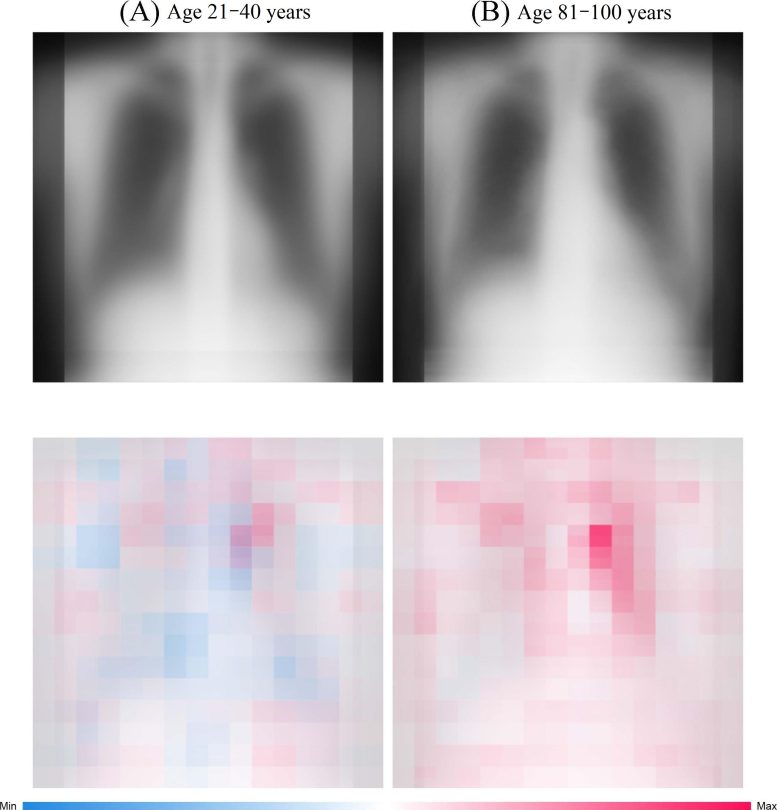An AI-powered model utilizes chest X-rays to help develop biomarkers for aging.
What if determining "your age" was based on your chest rather than your face? Scientists from Osaka Metropolitan University have crafted an advanced AI model that uses chest X-rays to precisely gauge a patient's actual age. Importantly, when there is a disparity, it can signal a correlation with chronic disease.
This breakthrough in medical imaging paves the way for enhanced early disease identification and treatment. The research was recently published in the journal The Lancet Healthy Longevity.
The research team, led by graduate student Yasuhito Mitsuyama and Dr. Daiju Ueda from the Department of Diagnostic and Interventional Radiology at the Graduate School of Medicine, Osaka Metropolitan University, first constructed a deep learning-based AI model to estimate age from chest radiographs of healthy individuals.

The upper images are the chest radiographs of patients from 21 to 40 years old and from 81 to 100 years old chronologically and the lower images are a visualization of the AI's focus (both after averaging). Red indicates the points most useful for age determination. Credit: Yasuhito Mitsuyama, OMU
They then applied the model to radiographs of patients with known diseases to analyze the relationship between AI-estimated age and each disease. Given that AI trained on a single dataset is prone to overfitting, the researchers collected data from multiple institutions.
For the development, training, internal and external testing of the AI model for age estimation, a total of 67,099 chest radiographs were obtained between 2008 and 2021 from 36,051 healthy individuals who underwent health check-ups at three facilities. The developed model showed a correlation coefficient of 0.95 between the AI-estimated age and chronological age. Generally, a correlation coefficient of 0.9 or higher is considered to be very strong.
To validate the usefulness of AI-estimated age using chest radiographs as a biomarker, an additional 34,197 chest radiographs were compiled from 34,197 patients with known diseases from two other institutions. The results revealed that the difference between AI-estimated age and the patient's chronological age was positively correlated with a variety of chronic diseases, such as hypertension, hyperuricemia, and chronic obstructive pulmonary disease. In other words, the higher the AI-estimated age compared to the chronological age, the more likely individuals were to have these diseases.
"Chronological age is one of the most critical factors in medicine," stated Mr. Mitsuyama. "Our results suggest that chest radiography-based apparent age may accurately reflect health conditions beyond chronological age. We aim to further develop this research and apply it to estimate the severity of chronic diseases, to predict life expectancy, and to forecast possible surgical complications."
Reference: "Chest radiography as a biomarker of ageing: artificial intelligence-based, multi-institutional model development and validation in Japan" by Yasuhito Mitsuyama, Toshimasa Matsumoto, Hiroyuki Tatekawa, Shannon L Walston, Tatsuo Kimura, Akira Yamamoto, Toshio Watanabe, Yukio Miki and Daiju Ueda, 16 August 2023, The Lancet Healthy Longevity.
DOI: 10.1016/S2666-7568(23)00133-2
News
Lower doses of immunotherapy for skin cancer give better results, study suggests
According to a new study, lower doses of approved immunotherapy for malignant melanoma can give better results against tumors, while reducing side effects. This is reported by researchers at Karolinska Institutet in the Journal of the National [...]
Researchers highlight five pathways through which microplastics can harm the brain
Microplastics could be fueling neurodegenerative diseases like Alzheimer's and Parkinson's, with a new study highlighting five ways microplastics can trigger inflammation and damage in the brain. More than 57 million people live with dementia, [...]
Tiny Metal Nanodots Obliterate Cancer Cells While Largely Sparing Healthy Tissue
Scientists have developed tiny metal-oxide particles that push cancer cells past their stress limits while sparing healthy tissue. An international team led by RMIT University has developed tiny particles called nanodots, crafted from a metallic compound, [...]
Gold Nanoclusters Could Supercharge Quantum Computers
Researchers found that gold “super atoms” can behave like the atoms in top-tier quantum systems—only far easier to scale. These tiny clusters can be customized at the molecular level, offering a powerful, tunable foundation [...]
A single shot of HPV vaccine may be enough to fight cervical cancer, study finds
WASHINGTON -- A single HPV vaccination appears just as effective as two doses at preventing the viral infection that causes cervical cancer, researchers reported Wednesday. HPV, or human papillomavirus, is very common and spread [...]
New technique overcomes technological barrier in 3D brain imaging
Scientists at the Swiss Light Source SLS have succeeded in mapping a piece of brain tissue in 3D at unprecedented resolution using X-rays, non-destructively. The breakthrough overcomes a long-standing technological barrier that had limited [...]
Scientists Uncover Hidden Blood Pattern in Long COVID
Researchers found persistent microclot and NET structures in Long COVID blood that may explain long-lasting symptoms. Researchers examining Long COVID have identified a structural connection between circulating microclots and neutrophil extracellular traps (NETs). The [...]
This Cellular Trick Helps Cancer Spread, but Could Also Stop It
Groups of normal cbiells can sense far into their surroundings, helping explain cancer cell migration. Understanding this ability could lead to new ways to limit tumor spread. The tale of the princess and the [...]
New mRNA therapy targets drug-resistant pneumonia
Bacteria that multiply on surfaces are a major headache in health care when they gain a foothold on, for example, implants or in catheters. Researchers at Chalmers University of Technology in Sweden have found [...]
Current Heart Health Guidelines Are Failing To Catch a Deadly Genetic Killer
New research reveals that standard screening misses most people with a common inherited cholesterol disorder. A Mayo Clinic study reports that current genetic screening guidelines overlook most people who have familial hypercholesterolemia, an inherited disorder that [...]
Scientists Identify the Evolutionary “Purpose” of Consciousness
Summary: Researchers at Ruhr University Bochum explore why consciousness evolved and why different species developed it in distinct ways. By comparing humans with birds, they show that complex awareness may arise through different neural architectures yet [...]
Novel mRNA therapy curbs antibiotic-resistant infections in preclinical lung models
Researchers at the Icahn School of Medicine at Mount Sinai and collaborators have reported early success with a novel mRNA-based therapy designed to combat antibiotic-resistant bacteria. The findings, published in Nature Biotechnology, show that in [...]
New skin-permeable polymer delivers insulin without needles
A breakthrough zwitterionic polymer slips through the skin’s toughest barriers, carrying insulin deep into tissue and normalizing blood sugar, offering patients a painless alternative to daily injections. A recent study published in the journal Nature examines [...]
Multifunctional Nanogels: A Breakthrough in Antibacterial Strategies
Antibiotic resistance is a growing concern - from human health to crop survival. A new study successfully uses nanogels to target and almost entirely inhibit the bacteria P. Aeruginosa. Recently published in Angewandte Chemie, the study [...]
Nanoflowers rejuvenate old and damaged human cells by replacing their mitochondria
Biomedical researchers at Texas A&M University may have discovered a way to stop or even reverse the decline of cellular energy production—a finding that could have revolutionary effects across medicine. Dr. Akhilesh K. Gaharwar [...]
The Stunning New Push to Protect the Invisible 99% of Life
Scientists worldwide have joined forces to build the first-ever roadmap for conserving Earth’s vast invisible majority—microbes. Their new IUCN Specialist Group reframes conservation by elevating microbial life to the same urgency as plants and [...]





















